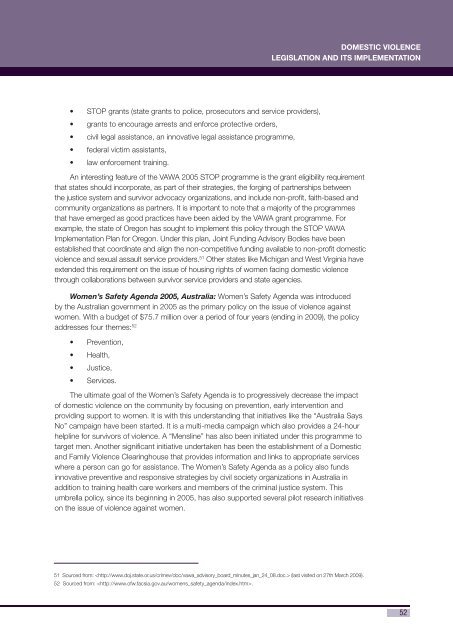Domestic Violence Legislation and its Implementation
Domestic Violence Legislation and its Implementation
Domestic Violence Legislation and its Implementation
Create successful ePaper yourself
Turn your PDF publications into a flip-book with our unique Google optimized e-Paper software.
• STOP grants (state grants to police, prosecutors <strong>and</strong> service providers),<br />
• grants to encourage arrests <strong>and</strong> enforce protective orders,<br />
• civil legal assistance, an innovative legal assistance programme,<br />
• federal victim assistants,<br />
• law enforcement training.<br />
DOMESTIC VIOLENCE<br />
LEGISLATION AND ITS IMPLEMENTATION<br />
An interesting feature of the VAWA 2005 STOP programme is the grant eligibility requirement<br />
that states should incorporate, as part of their strategies, the forging of partnerships between<br />
the justice system <strong>and</strong> survivor advocacy organizations, <strong>and</strong> include non-profi t, faith-based <strong>and</strong><br />
community organizations as partners. It is important to note that a majority of the programmes<br />
that have emerged as good practices have been aided by the VAWA grant programme. For<br />
example, the state of Oregon has sought to implement this policy through the STOP VAWA<br />
<strong>Implementation</strong> Plan for Oregon. Under this plan, Joint Funding Advisory Bodies have been<br />
established that coordinate <strong>and</strong> align the non-competitive funding available to non-profi t domestic<br />
violence <strong>and</strong> sexual assault service providers. 51 Other states like Michigan <strong>and</strong> West Virginia have<br />
extended this requirement on the issue of housing rights of women facing domestic violence<br />
through collaborations between survivor service providers <strong>and</strong> state agencies.<br />
Women’s Safety Agenda 2005, Australia: Women’s Safety Agenda was introduced<br />
by the Australian government in 2005 as the primary policy on the issue of violence against<br />
women. With a budget of $75.7 million over a period of four years (ending in 2009), the policy<br />
addresses four themes: 52<br />
• Prevention,<br />
• Health,<br />
• Justice,<br />
• Services.<br />
The ultimate goal of the Women’s Safety Agenda is to progressively decrease the impact<br />
of domestic violence on the community by focusing on prevention, early intervention <strong>and</strong><br />
providing support to women. It is with this underst<strong>and</strong>ing that initiatives like the “Australia Says<br />
No” campaign have been started. It is a multi-media campaign which also provides a 24-hour<br />
helpline for survivors of violence. A “Mensline” has also been initiated under this programme to<br />
target men. Another signifi cant initiative undertaken has been the establishment of a <strong>Domestic</strong><br />
<strong>and</strong> Family <strong>Violence</strong> Clearinghouse that provides information <strong>and</strong> links to appropriate services<br />
where a person can go for assistance. The Women’s Safety Agenda as a policy also funds<br />
innovative preventive <strong>and</strong> responsive strategies by civil society organizations in Australia in<br />
addition to training health care workers <strong>and</strong> members of the criminal justice system. This<br />
umbrella policy, since <strong>its</strong> beginning in 2005, has also supported several pilot research initiatives<br />
on the issue of violence against women.<br />
51 Sourced from: (last visited on 27th March 2009).<br />
52 Sourced from: .<br />
52

















